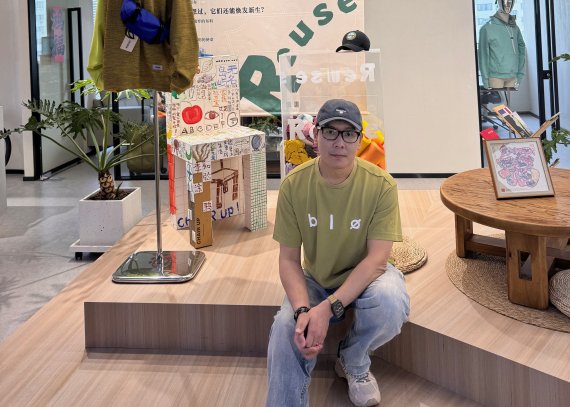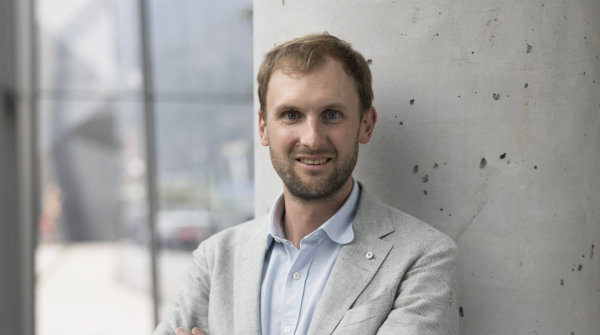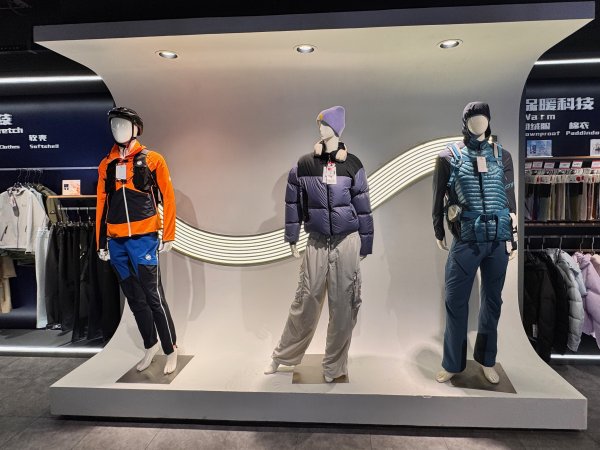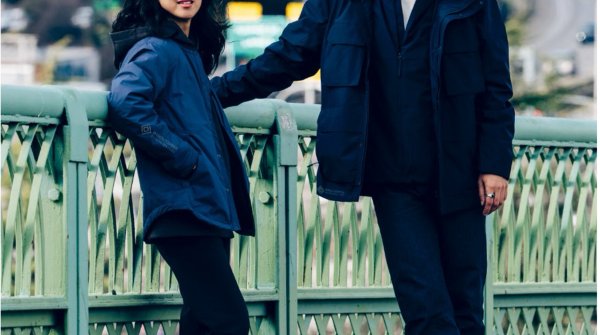SportsInnov Club: Building a Global Innovation Network
Oliver Wang, founder of the SportsInnov Club connects brands and retailers both in China and globally, creating an ecosystem for sports product innovation in China. By connecting premium China brands, including Bosideng and Kailas, Wang is a familiar face on the ISPO showground. His idea is to create a community with sports designers and help those sports brands to develop innovations.
SportsInnov Club's team is located in the stunning Design Innovation Institute Shanghai (DIIS): a beautiful 20th Century building combining Gothic Revival and Art Deco. It is dwarfed by the surrounding skyscrapers, especially the newly opened Shanghai Magnolia Plaza, with 320 meters height. Built in 1934, the building serves as a hub of innovation, not just for the sports and textiles sector but for traditional and modern industries alike.
The legacy of British magnate Henry Lester is evident as you walk through the building, where discussions and ideas from the last 80 years flow through the corridors and into the auditorium. Initially, the Henry Lester Institute of Technical Education, before the DIIS took the helm, was a non-profit organization funded by the Shanghai government. Now, it is home to multiple start-ups, including those embracing designs, food technology, pharmaceutical packaging, and AI, which are housed in individual high-ceiling rooms with large windows for naturally lit spaces. An oasis of the past that houses the developments of the future. It is no surprise that there is a waiting list for start-ups from all industries.

LifeLabs: Redefining Comfort with Nanotechnology
In a previously academic environment, it is quite fitting to find LifeLabs, the winner of the ISPO Textrends Best Product for Insulation, located there. Benton Wang, marketing director, told ISPO the actual nanotechnology-based textile innovation can dynamically manage the infrared radiation from the human body to provide thermal comfort. This technolgy is a result of the work of Professor Yi Cui of Stanford University, who was initially looking into more efficient energy use as Professor of Materials Science and Engineering and efficiency in buildings.
The technology utilizes a polyethylene (PE) material with a specific structure that can either reflect or transmit the body's infrared radiation, depending on the ambient temperature. This allows the textile to keep the body at an optimal temperature range of 33-34°C.
Benton Wang explained
The technology is being commercialized in two product lines - "Cool Life" for cooling and "Warm Life" for warming. The company is working with textile mills to integrate this technology into various fabric blends and is also exploring sustainable dyeing methods like dope-dyeing to enhance the product's environmental benefits further.
Across town, Unitex, the award-winning circular and warp knitter with green-level factory certification and bluesign accreditation, has established the Design Innovation Centre. This immersive space is a far cry from the showrooms of the past, yet one that offers an engaging experience where information is shared.
Chris Lei, director of innovation, emphasizes
We welcome visits from global brand partners, academic researchers, and innovation teams who are passionate about material advancement and responsible manufacturing. The Centre fosters hands-on experimentation and deep dialogue around product ideation, testing, and commercialization.
The decision to invest in and create this inspirational space, which combines a coffee shop and an art gallery featuring textiles, is in line with the philosophy that Unitex is built on: sustainability.
Lei added
Our next major goal is to deepen our presence in key global markets by aligning cutting-edge textile innovation with sustainability at every level of our operation. As one of the few mills built from the ground up with a sustainability-first mindset, we are committed to leading the industry. Not just by offering eco-conscious materials, but by transforming the supply chain itself. We are also exploring cross-sector partnerships that will enable traceability, closed-loop recycling, and greater transparency. An essential leap for the industry.
For the future, Lei envisions a supply chain that is not only leaner but also smarter: with digitalization, traceability, and shared responsibility at its core. The implementation of broader adoption of blockchain-enabled material tracking, on-demand production to reduce excess inventory, and greater integration of carbon accounting tools across suppliers is also on the horizon.

Suntion China Group, another award-winning textile manufacturer, is halfway through their latest investment, which is taking them to becoming a vertical textile supplier. With an investment of 1 billion Yuan (approximately $ 120 million), the final stage of their state-of-the-art spinning factory is scheduled to open at the beginning of next year.
Walking the latest addition to the factory and seeing the state-of-the-art equipment being installed, the scales give you a sense that Suntion is serious about moving forward and delivering an efficient offering.
Despite market uncertainty, especially with increased tariffs to the US, the mood from China is you have to speculate to accumulate regardless of the disruption. The investment and development vertically leads to a more efficient supply chain, which is appealing when it comes to the arrival of the digital product passport (DPP) and complete transparency of sourcing and manufacturing. It is also a way to invest: to improve the efficiency of the supply chain also enables a stronger sustainability.
However, the downside to any new developments and investments is that they have a knock-on effect on existing and established textile companies that haven't pursued a vertical output, leading to closures, which is a pain point for an ambitious economy.
You want to stay ahead on sustainability and global regulations?
Then subscribe to our free newsletter for the latest updates and insights.
The same can be said about Shanghai retail, as it moves north up the Bund and shifts away from traditional skyscraper shopping malls to more immersive experiences with outdoor spaces. Shanghai Xintiandi is a large-scale, master-planned city core redevelopment project comprising residential, office, retail, entertainment, and cultural properties in the heart of the city. This flagship development seamlessly integrates early 20th-century Shikumen architecture with contemporary urban lifestyle, fashion elements, modern features, and facilities.
The urban renewal project was initiated by private investment from Hong Kong, with a government land tender involved in the acquisition of the area, paving the way for other investors to enter the mainland. This isn't just happening in Shanghai but throughout China's first and second-tier cities.
The outdoor space is a network of old streets featuring restaurants from around the globe, alongside luxury brands from fashion and beauty, as well as sports and outdoors, including Lululemon, ON Running, and Descente.
The latest Government investment is focused on the development of the north of the Bund. Green areas outline the river, providing opportunities for running, cycling, or skateboarding. The Chinese Government has always been keen on keeping a population of over 1 billion people active, recognizing the benefits of sport on public health.
Youth fitness is key, with data released in 2024 showing that 19 percent of Chinese children aged 6 to 17 are overweight or obese, while another study in 2023 found that 52.7 percent are affected by myopia. In response, China's 14th Five-Year Plan, set to conclude in 2025, and its long-range objectives through 2035 call for implementing a preschool nutrition improvement program, controlling childhood obesity and myopia, and ensuring time for school physical education and extracurricular exercise.

Selling in China isn't as easy as it was in the past, where a brand name alone would generate sales. Competition is fierce, especially among the new Gen Y designers and consumers alike, and if you don't have a unique selling point (USP), it's best to avoid it.
As Oliver Wang from SportsInnov Club explained:
So I think for the new generation from China, those Chinese young people, there's nothing special with a brand, whether it comes from abroad or local China, it has to have a special reason for them to buy. For my generation, and even those a little younger, we still think, 'Ah, okay, the brands from the US and Europe must be better.' However, for the young generation, it's the same. I think everyone is saying, if I want to buy you, I buy this brand; there must be a reason.
China-grown sports and outdoor brands are emerging as top choices, offering high-quality ingredients, competitive prices, and a retail experience. Banana In is one such brand delivering on all points, from performance to price. But despite the investment in bricks and mortar, it isn't the offline locations that generate the sales.
Wang pointed out
If the only accounts rely on the offline sales, they never can break even. So these offline sales deliver the experience, deliver the value, add value feeling to the consumers that they, in the end, will purchase online.
This is evident in many retail spaces, where instead of bustling sales, you often see the opposite.
Offering advice for brands to enter the China market, Wang is cautious
So as long as it's unique, they have a better chance. Of course, the strategy and the partners are also essential; it's a highly complex market. You need to identify the target consumers and determine how to effectively reach them through online channels, e-commerce, social media, or even an offline experience center. Even like the clubs, some of them are offering clubs and, you know, connecting that way.
What is interesting is that some brands considering entering the market are building up their following before even opening a sales platform.

It isn't just youth health that the Chinese Government has its eyes on, it is also cross-generational. Across the Bund, a green area has been developed for day camping, where consumers come with all their kit to set up for the day.
Wang shared
The pandemic was a trigger point for the whole society to have more focus and more attention towards health and welfare and in general like to also that's the motivation. At the same time, I believe the Government's facility infrastructure development delivers powerful support for this kind of growth or expansion. As you can imagine, the banks of the river have been significantly affected by the Government over the last five years. So you can run and cycle along it.
The green areas along the Bund, which provide opportunities for the Shanghai population to take time out for sporting activities and day camping, are encouraging more consumers to experience this. With parking readily available under the Bund, a handy app connects you to restaurants to deliver food directly to your location. You pack up and go back home. Daytime camping is the new leisure and social activity, and considering the number of consumers, the potential is enormous for both apparel and equipment.
China’s evolving textile and sports landscape offers significant opportunities for the global sports business. Investments in vertical supply chains and smart production create efficiency and transparency, while innovation hubs open doors for cross-sector collaboration. At the same time, new retail concepts and health-driven initiatives are shaping consumer behavior, offering brands and retailers fresh entry points into a dynamic market. For the sports industry, these shifts present a chance to align with sustainability, tap into growing demand, and strengthen international partnerships.
Discover the latest retail concepts, innovations, and business opportunities for your brand at ISPO 2025. As the global sports industry’s leading event, ISPO offers an in-depth look at China’s retail strategies and best practices. Together with market expert Oliver Wang, we’ll explore key market shifts and how brands can successfully adapt. From 30. NOV. – 02. DEC. in Munich.
- Innovation hubs: Cross-industry spaces bring together start-ups, research, and design, creating fertile ground for new sports and textile solutions.
Advanced materials: Sustainable fibers, nanotechnology, and circular approaches set new benchmarks for performance and eco-responsibility.
Vertical supply chains: Major investments aim to streamline production, ensure transparency, and strengthen sustainability from fiber to retail.
Retail transformation: Shopping shifts from traditional malls to immersive lifestyle spaces. Offline retail builds brand experience, while actual sales increasingly happen online.
Health focus: Government programs promote youth fitness, combat obesity and myopia, and expand outdoor infrastructure—driving long-term demand for sports and leisure products.

 Sports BusinessSki Mountaineering Goes Olympic: What Milano-Cortina 2026 Means
Sports BusinessSki Mountaineering Goes Olympic: What Milano-Cortina 2026 Means
- ISPO awards
- Mountain sports
- Bike
- Design
- Retail
- Fitness
- Health
- ISPO Job Market
- ISPO Munich
- ISPO Shanghai
- Running
- Brands
- Sustainability
- Olympia
- OutDoor
- Promotion
- Sports Business
- ISPO Textrends
- Triathlon
- Water sports
- Winter sports
- eSports
- SportsTech
- OutDoor by ISPO
- Heroes
- Transformation
- Sport Fashion
- Urban Culture
- Challenges of a CEO
- Trade fairs
- Sports
- Find the Balance
- Product reviews
- Newsletter Exclusive Area
- Magazine


